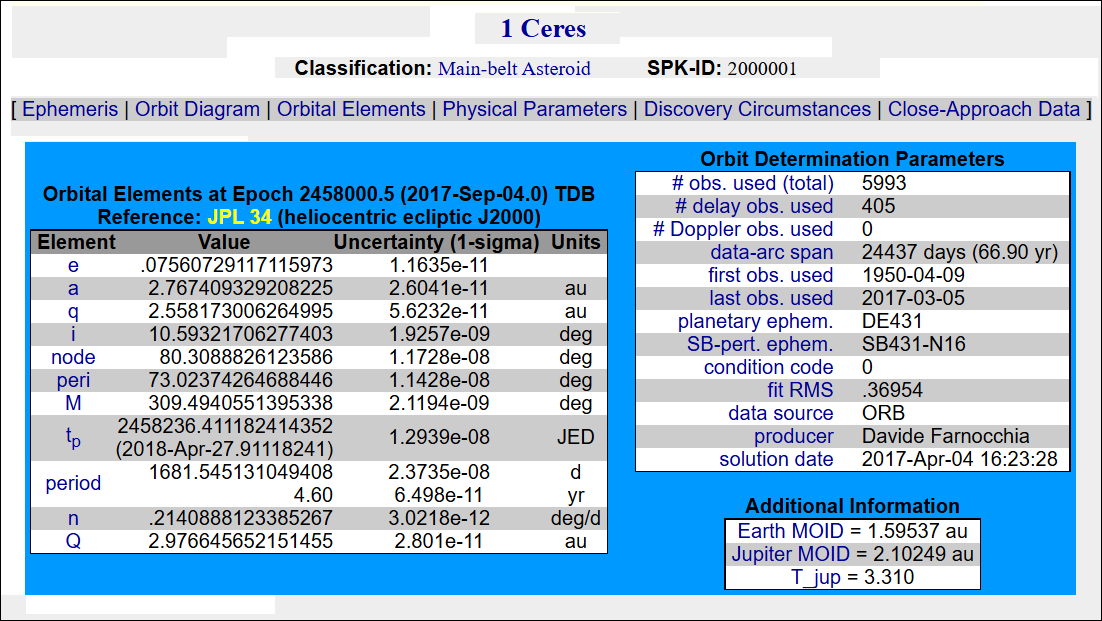Ceres - The Dwarf Planet within The Asteroid Belt
On the 1st of January 1801, Italian astronomer Giuseppe Piazzi (1746-1826) made an unexpected discovery while observing the skies from the Palermo Astronomical Observatory in Sicily: a faint moving object between Mars and Jupiter. Initially mistaken for a comet, this body would later be recognized as the largest member of the asteroid belt: the dwarf planet Ceres. Named after the Roman goddess of agriculture, its discovery marked the first detection of what was then considered a new planet. German mathematician Carl Friedrich Gauss (1777-1855) played a crucial role in calculating its orbit, using Piazzi’s limited observations to predict its position and confirm its existence as a solar system object.
With a diameter of 939.4 ± 0.2 km, Ceres is the smallest known dwarf planet—far smaller than Earth’s Moon, which spans 3476 km. Despite its modest size however, it dominates the asteroid belt, containing roughly one-third of the region’s total mass. Its gravitational influence has shaped it into a nearly round body, meeting the IAU’s criteria for dwarf planet classification. Unlike most asteroids, which are irregular fragments, Ceres has a complex structure, with a rocky core and a mantle rich in ice water.
A Prominent Body Involved in End-Times Alignments
In the course of my research examining planetary alignments of the deep past, the main software package that I make use of is Starry Night pro. 6.0. A very exacting package that provides periodic updates to its users e.g. the addition of newly discovered celestial bodies, or the (seeming) refinement of the orbital elements of ‘small bodies’ present within the solar system – i.e. not the major planets.
Now this point has dramatic implications for some of the alignment patterns that I have identified in the course of my work, as depicted in many screenshot images taken from Starry Night.
The ‘Miracle Solution’ for Ceres
Whilst in the most productive and creative phase of my research, several years ago, the orbital solution for Ceres in Starry Night 6.0 revealed it to be a celestial body of exceptional significance, profoundly linked to a number of global disaster alignments. Its placement was exacting to some of the most prominent conjunction patterns of note, stretching far back into history.
The elements of the orbital solution in question are as follows:

This exact solution (above), as pre-programmed into the Starry Night 6.0 software, was the one that I was using for quite a few years. After a time however, a (periodic) update occurred which replaced this solution with a different one. An inferior solution to be sure. One that just tweaked the orbital elements ever so slightly as to render it useless for research purposes.
As a result, when trying to locate Ceres under the new solution, several thousand years into the past at various points, it was found to be in a completely different location. It was thus no longer shown to be present in many of the profound alignments as identified up to that point in my research.
What I came to realise then, was that inadvertently, the original solution that I was using was the correct solution. The most accurate orbital solution for Ceres that could be obtained; though for some reason, it had been replaced by a degraded solution. In order to continue my research therefore, I had to make use of a very special feature contained within the Starry Night software: The ability to create a new celestial body and add it to the solar system.
To make use of this feature, I firstly had to locate the old solution for Ceres. This was achieved using the ‘Way back When Machine’ website, which contained an archive of the ‘original orbital solution’ from the Jet Propulsion Laboratory’s own website (as detailed in the image above). With this in hand, I created - or rather recreated - Ceres as a new celestial body to add to the solar system, using the old recovered solution.
Checking my work
I certainly expect that a number of people with astronomy software of their own will want to input into it the various dates that I have identified, to see the planetary alignments for themselves that I have shown in the screenshot images in my essays.
Now although I have great confidence that all of the major planets will be exactly where they are upon the dates in question, that may not be the case for those alignments that involve Ceres. Not unless the astronomy software being used makes use of exactly the same Ceres solution that I am using. Namely, the recovered solution detailed above.
For those not using this exact solution, Ceres will not be where I show it to be. In order to fully reconstruct my work therefore, it will thus be necessary for anyone out there to modify the orbital elements of Ceres within the astronomy software they are using, or if that is not possible, to use a program feature (if it exists) to create an alternate Ceres based upon the recovered orbital solution, given above.